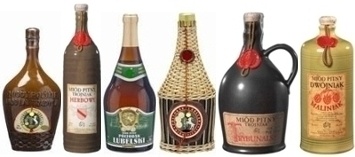![]()
Sometimes known as honey wine, mead is a fermented alcoholic beverage made from diluted honey. The amount of mead and water determines the basic type of mead produced. These type include połtoraki (1.5 part of honey to 1 part of water), dwojniaki (1:1), trojniaki (2:1), and czworniaki (3:1).
There are meads of the highest quality and the widest variety from heavy sweet meads with the highest content of honey and alcohol (15-17%) such as połtoraki and dwojniaki through trojniaki with 12-14% of alcohol to light dry meads such as czworniaki with 9-11% of alcohol.


Whatever the type or kind of mead, its production requires particular supervision and care. Since maturation is key, all currently used production methods are based on traditional recipes and technology. Meads have a unique alcoholic flavour and a high nutritious value due to the high content of natural honey and no added aromas, colorants or preservatives.

Presently Poland is the only country in the world in which mead is produced on an industrial scale. It is probably no wonder that meads are so strongly identified with our country.